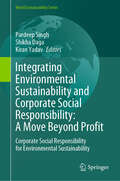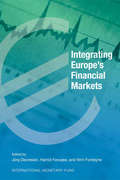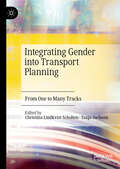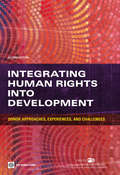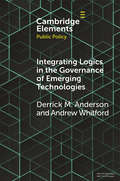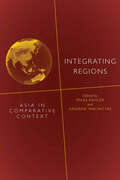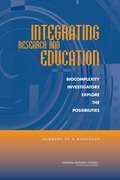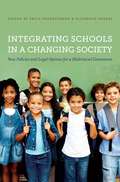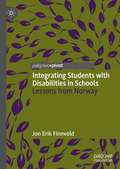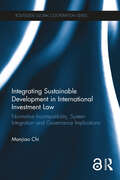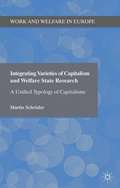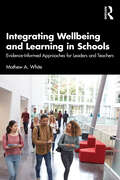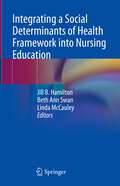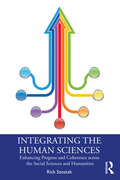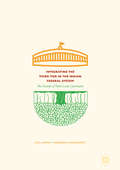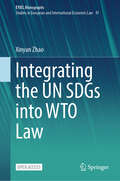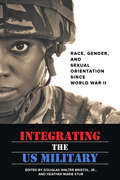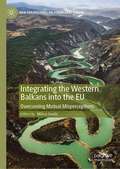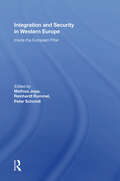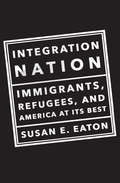- Table View
- List View
Integrating Environmental Sustainability and Corporate Social Responsibility: Corporate Social Responsibility for Environmental Sustainability (World Sustainability Series)
by Pardeep Singh Shikha Daga Kiran YadavThis book offers a comprehensive detail about the role that corporate social responsibility can play in promoting sustainable development thereby ensuring a resilient and greener future for all. The book emphasises how business strategies and environmental harmony are becoming more integrated, thereby supporting the agenda towards a sustainable development. The synergistic and symbiotic relationship between social responsibility and sustainability has evolved over the years with enterprises becoming more aware of their commitment towards ethical, equitable, inclusive, and environmentally conscious practices. Adopting a socially responsible attitude by the new age entrepreneurs represents the paradigm shift in how corporations understand and undertake their regular activities. The traditional objective of wealth maximisation that the enterprises followed led to severe misutilisation of resources in terms of its environmental and societal impact and led to severe corporate disasters. It gave rise to adopting alternative objectives that are not only holistic but also combine concern for profits, humanity, society, and, above all, the environment. The result is that almost every major corporation has adopted a code of conduct and established the necessary management structures and procedures to ensure compliance with the newly framed objective of socially responsible profits. Consequently, the concept of corporate social responsibility has acquired momentum in recent times. This has come after the realisation that social responsibility is a significant environmental and organisational sustainability dimension that only some enterprises can sustain for a while. Over the years, this harmonisation has ushered in significant progress, reshaping the perspective of businesses towards their societal and environmental impact.
Integrating Europe's Financial Markets
by Jörg Decressin Hamid Faruqee Wim FonteyneThis publication traces the European Union's journey along the path to a single financial market and identifies the challenges and priorities that remain ahead. It examines recent integration efforts in the EU following the introduction of the euro, the importance of financial integration for economic growth, the interplay between banks and markets, and equity market integration, as well as the relationship between financial integration and financial stability.
Integrating Gender into Transport Planning: From One to Many Tracks
by Christina Lindkvist Scholten Tanja JoelssonThis edited collection brings together feminist research on transport and planning from different epistemologies, with the intention to contribute to a more holistic transport planning practice. With a feminist perspective on transport policy and planning, the volume insists on the political character of transport planning and policy, and challenges gender-blindness in a policy area that impacts the everyday lives of women, men, girls, and boys. The chapters discuss everyday mobility as an embodied and situated activity in both conceptual and theoretical ways and suggest practical tools for change. The contributions of this collection are threefold: integrating gender research and transport planning, combining quantitative and qualitative gender research perspectives and methods, and highlighting the need to acknowledge the politicization of transport planning and transport practice.
Integrating Human Rights into Development
by World Bank OecdThe past two decades have witnessed a convergence between human rights and development, particularly at the level of international political statements and policy commitments. This phenomenon is captured in milestones such as the 2007 OECD DAC Action Oriented Policy Paper on Human Rights and Development (â œAOPPâ ?), the 2010 UN World Summit Outcome Document, the commitments of the 2005 and 2011 High-Level For an Aid Effectiveness in Accra and Busan. The connections between rights violations, poverty, exclusion, environmental degradation, vulnerability and conflict continue to be explored and better understood. More positively, there is growing recognition of the intrinsic importance of human rights in a range of contexts, as well as their potential instrumental relevance for improving development processes and outcomes. This second edition of Integrating Human Rights into Development: Donor Approaches, Experiences and Challenges consolidates the research and findings complied in 2006 with relevant developments that have occurred in the intervening six years. It brings together the key political and policy statements of recent years with a discussion of the approaches and experiences of bilateral and multilateral agencies engaged in integrating human rights in their development cooperation activities in a variety of ways. Despite rapid changes in the donor landscape and acute budget pressures resulting from the financial crisis, the experience of the past six years also attests to the sustained commitment of OECD member countries and multilateral donors to engage with human rights strategically, as a means for improving the ways they deliver and manage aid and the quality of development co-operation.
Integrating Logics in the Governance of Emerging Technologies: The Case of Nanotechnology (Elements in Public Policy)
by Derrick Mason Anderson Andrew WhitfordThe governance of emerging technologies does not follow a single governance paradigm because of complex interactions between government, industry, and civil actors. In this Element, we will argue that for emerging technologies, governance is a 'convergent paradigm'. We introduce governance issues associated with emerging technologies generally before turning to the specifics of nanotechnology. We then approach governance theory and practice by considering different perspectives on governance by their different orientations with respect to object and process. Finally, we construct a matrix of object and process oriented governance activities observed in the case of nanotechnology in the United States.
Integrating Regions: Asia in Comparative Context
by Andrew Macintyre Miles KahlerThe proliferation of regional institutions and initiatives in Asia over the past decade is unmatched in any other region of the world. The authors in this collection explore the distinctive features of these institutions by comparing them for the first time to the experience of other regions; from the elaborate institution-building of Europe to the more modest regional projects of the Americas. It is an opportune moment for this reassessment, as the European regional model faces a sovereign debt crisis while Asian economies see more secure sources of growth from their immediate neighbors. Asias regional institutions display a distinctive combination of decision rules, commitment devices, and membership practices, shaped by underlying features of the region, the dynamics of regional integration, and the availability of institutional substitutes. Within this context, the authors propose changes that will better sustain the prosperity and peace that have marked Asia in recent decades.
Integrating Research And Education: Biocomplexity Investigators Explore The Possibilities
by Bridget K. B. AvilaThe workshop summary provides guidance for researchers applying to the National Science Foundation (NSF) for funding. New NSF guidelines require applications to address the "broader impact" of the proposed research. Presentations at the workshop provided ideas on how to do this by engaging in undergraduate education, K-12 education or public outreach via museums or journalists. The workshop summary discusses issues to consider in choosing an appropriate collaborator for the education or outreach component of the project and how to build in methods for assessing the success of the project. It also provides lists of resources helpful in writing education proposals and discusses the similarities between research in education and scientific research.
Integrating Schools in a Changing Society
by Erica Frankenberg Elizabeth DebrayIn this comprehensive volume, a roster of leading scholars in educational policy and related fields offer eighteen essays seeking to illuminate new ways for American public education to counter persistent racial and socioeconomic inequality in our society. Contributors to Integrating Schools in a Changing Society draw on extensive research to reinforce the key benefits of racially integrated schools, examine remaining options to pursue multiracial integration, and discuss case examples that suggest how to build support for those efforts.
Integrating Science and Politics for Public Health (Palgrave Studies in Public Health Policy Research)
by Adèle Cassola Evelyne De Leeuw Patrick FafardThis open access book bridges the divide between political science and public health, whilst simultaneously embracing the complexities and differences of both. Although public health is inherently political, the tools and insights of political science are often ignored in public health scholarship. Bringing together academics and researchers working at the intersection of both, the book demonstrates how integrating these fields can help reconcile the roles of politics and scientific evidence in policymaking. It also highlights the key conceptual, methodological and substantive implications for bridging this divide, and charts a path forward for a movement towards political science with public health. It will be of interest to academics, researchers and students interested in public health, political science, public policy, and the role of scientific evidence in policymaking.
Integrating Social Media into Information Systems: Requirements, Gaps, and Potential Solutions (G - Reference, Information and Interdisciplinary Subjects)
by Parisa Roshan Isaac R. Porche III Ryan Andrew Brown Astrid Stuth Cevallos Osonde A. Osoba Joshua Mendelsohn Douglas Douglas Yeung John Bordeaux Timothy R. Gulden Laura Kupe Luke J. Matthews Katharine Sieck Sarah SolimanThis report examines the technical challenges associated with incorporating bulk, automated analysis of social media information into procedures for vetting people seeking entry into the United States. The authors identify functional requirements and a framework for operational metrics for the proposed social media screening capabilities and provide recommendations on how to implement those capabilities.
Integrating Southern Europe: EC Expansion and the Transnationalization of Spain
by Otto HolmanIntegrating Southern Europe presents a stimulating comparative analysis of the position of Spain within the European Community and within the global economy. It combines a historical perspective with an analysis of the process of the democratization in Southern Europe and of Spain's increasingly trans-European outlook.
Integrating Students with Disabilities in Schools: Lessons from Norway
by Jon Erik FinnvoldThis book explores the ability of the Norwegian school system to support the achievement of formal competencies among children with physical disabilities, as well as its role in the informal dimensions of social participation and networking. Schools contribute to social inclusion in several ways: they are arenas for building official competencies, ensuring future access and success in the labour market. They are also sites for meeting other children, and developing friendships – friendships are not only important for strengthening cognitive development, but are vital to both good mental health and the building of various forms of social capital. By examining schools and the ways in which inclusion is incorporated early, this book aims to bridge the opportunity and employment gap that people with physical disabilities are more likely to face later in life.
Integrating Sustainable Development in International Investment Law: Normative Incompatibility, System Integration and Governance Implications (ISSN)
by Manjiao ChiThe current international investment law system is insufficiently compatible with sustainable development. To better address sustainable development concerns associated with transnational investment activities, international investment agreements should be made more compatible with sustainable development.Integrating Sustainable Development in International Investment Lawpresents an important systematic study of the issue of sustainable development in the international investment law system, using conceptual, normative and governance perspectives to explore the challenges and possible solutions for making international investment law more compatible with sustainable development. Chi suggests that to effectively address the sustainable development concerns associated with transnational investment activities, the international investment agreements system should be reformed. Such reform should feature redesigning the provisions of the agreements, improving the structure of international investment agreements, strengthening the function of soft law, engaging non-state actors and enhancing the dispute settlement mechanism.The book is primarily aimed at national and international treaty and policy-makers, lawyers and scholars. It is also suitable for graduate students studying international law and policy-making.The Open Access version of this book, available at http://www.taylorfrancis.com, has been made available under a Creative Commons Attribution-Non Commercial-No Derivatives (CC-BY) 4.0 license.
Integrating Sustainable Development in International Investment Law: Normative Incompatibility, System Integration and Governance Implications (Routledge Global Cooperation Series)
by Manjiao ChiThe current international investment law system is insufficiently compatible with sustainable development. To better address sustainable development concerns associated with transnational investment activities, international investment agreements should be made more compatible with sustainable development. Integrating Sustainable Development in International Investment Law presents an important systematic study of the issue of sustainable development in the international investment law system, using conceptual, normative and governance perspectives to explore the challenges and possible solutions for making international investment law more compatible with sustainable development. Chi suggests that to effectively address the sustainable development concerns associated with transnational investment activities, the international investment agreements system should be reformed. Such reform should feature redesigning the provisions of the agreements, improving the structure of international investment agreements, strengthening the function of soft law, engaging non-state actors and enhancing the dispute settlement mechanism. The book is primarily aimed at national and international treaty and policy-makers, lawyers and scholars. It is also suitable for graduate students studying international law and policy-making.
Integrating Varieties of Capitalism and Welfare State Research: A Unified Typology of Capitalisms (Work and Welfare in Europe)
by Martin SchröderThis book combines the two most important typologies of capitalist diversity; Esping-Andersen's welfare regime typology and Hall and Soskice's 'Varieties of Capitalism' typology, into a unified typology of capitalist diversity. The author shows empirically that certain welfare states bundle together with certain production systems.
Integrating Wellbeing and Learning in Schools: Evidence-Informed Approaches for Leaders and Teachers
by Mathew A. WhiteIntegrating Wellbeing and Learning in Schools argues that wellbeing research can help address the hurdles that school leaders face by incorporating a more interdisciplinary approach from contemporary governance, leadership, and management. The COVID-19 pandemic has accelerated the problem of the wellbeing learning poverty cycle in schools worldwide. This book makes the case for a new and comprehensive integration of wellbeing in school governance, leadership, and teaching theories across disciplines during the recovery phase of the COVID-19 pandemic. It argues for operationalising wellbeing goals and integrating these into evidence-informed professional practice. Drawing on evidence-informed wellbeing education, teaching theories, and original research, the book comprehensively considers the integration of wellbeing education from the perspectives of school governance and leadership, middle management, teachers, student leadership, and the students themselves. This book will be of interest to postgraduate students of education leadership, educators, and school leaders.
Integrating a Social Determinants of Health Framework into Nursing Education
by Beth Ann Swan Jill B. Hamilton Linda McCauleyThe purpose of this ground-breaking Textbook is to describe and illustrate, with pedagogical features, the process by which social determinants of health (SDOH) has been integrated throughout all courses in the Nell Hodgson Woodruff School of Nursing. Specifically, the authors describe initial steps to develop a comprehensive SDOH model for nursing education, followed by rigorously designed faculty educational materials, exemplars of SDOH instructional materials, and evaluation of this process from faculty and students. It describes a comprehensive framework that guides the development, implementation, and evaluation of SDOH across the pre-licensure and post-licensure curriculum and illustrate the process integrating SDOH throughout all aspects of didactic, simulation, and clinical education. Among the subjects addressed, the history of nursing and SDOH and the value of SDOH content in nursing courses to alleviate health disparities are described and mandates to integrate SDOH content into nursing curriculum by the leading nursing organizations are summarized. The authors also include a review of existing SDOH frameworks used in public health and medicine and present a comprehensive SDOH model for nursing education. A SDOH educational course content for faculty is detailed (Social Determinants of Health 101) and exemplars from faculty and students are provided along with an evaluation after the first year. The authors conclude with a discussion from faculty leadership; what they learned and their suggestions to other nursing programs. Although there are books published, no books exist on this topic for nursing education and practicing nurses, yet SDOH is foundational to nursing curriculum and practice. The leading nursing organizations are all mandating that SDOH be integrated into nursing courses. Hence this textbook will be a key resource for Schools of Nursing in the US and globally. The intended audience of this book are leaders and faculty of nursing education programs, national professional nursing organizations, practicing nurses at hospitals and health systems, community and public health agencies, and ambulatory care.
Integrating the Human Sciences: Enhancing Progress and Coherence across the Social Sciences and Humanities
by Rick SzostakWhat if we recognized that the human sciences collectively investigate a few dozen key phenomena that interact with each other? Can we imagine a human science that would seek to stitch its understandings of this system of phenomena into a coherent whole? If so, what would that look like? This book argues that we are unlikely to develop one unified "theory of everything." Our collective understanding must then be a "map" of the myriad relationships within this large – but finite and manageable – system, coupled with detailed understandings of each causal link and of important subsystems. The book outlines such a map and shows that the pursuit of coherence – and a more successful human science enterprise – requires integration, recognizing the strengths and weaknesses of different methods and theory types, and the pursuit of terminological and presentational clarity. It explores how these inter-connected goals can be achieved in research, teaching, library classification, public policy, and university administration. These suggestions are congruent with, and yet enhance, other projects for reform of the human sciences. This volume is aimed at any scholar or student who seeks to comprehend how what they study fits within a broader understanding.
Integrating the Third Tier in the Indian Federal System
by Atul Sarma Debabani ChakravartyThis book discusses the evolution of the third tier of the Indian federal system, with a focus on rural local governance (commonly known as Panchayati Raj) against the backdrop of important theoretical and empirical literature on the relevance and effectiveness of service delivery in the decentralized system. It evaluates the quintessence of the functioning of the Panchayati Raj in the past two decades of its existence. This pioneering book also discusses the treatment of the third-tier government in the inter-governmental fiscal transfer framework and the delineation of the unique institution of local self-government in the Northeastern Indian States. In the light of the loosely evolved fiscal relations between three levels of government, it has been observed that local self-governments in the bottom tier have not been truly empowered yet. The book argues in favor of integrating the third-tier government into the Indian federal system and suggests how this could be achieved.
Integrating the UN SDGs into WTO Law (European Yearbook of International Economic Law #41)
by Xinyan ZhaoThis is an open access book. Sustainable development is so important that humanity must do its utmost to achieve these goals for the well-being of the present and future generations. WTO members have started to reform WTO rules since the WTO’s Buenos Aires Ministerial Conference in 2017. The book describes a possible bright future for readers: WTO members can integrate the UN SDGs into WTO law (i.e., create sustainable trade rules) by establishing a sustainable development club and constitutionalising the WTO.
Integrating the US Military: Race, Gender, and Sexual Orientation since World War II
by Douglas Walter Bristol, Jr., and Heather Marie SturHow have the US Armed Forces been transformed by integration?One of the great ironies of American history since World War II is that the military—typically a conservative institution—has often been at the forefront of civil rights. In the 1940s, the 1970s, and the early 2000s, military integration and promotion policies were in many ways more progressive than similar efforts in the civilian world. Today, the military is one of the best ways for people from marginalized groups to succeed based solely on job performance.Integrating the US Military traces the experiences of African Americans, Japanese Americans, women, and gay men and lesbians in the armed forces since World War II. By examining controversies from racial integration to the dismantling of "Don’t Ask, Don’t Tell" to the recent repeal of the ban on women in combat, these essays show that the military is an important institution in which social change is confirmed and, occasionally, accelerated. Remarkably, the challenges launched against the racial, gender, and sexual status quo in the postwar years have also broadly transformed overarching ideas about power, citizenship, and America’s role in the world.The first comparative study of legally marginalized groups within the armed services, Integrating the US Military is a unique look at the history of military integration in theory and in practice. The book underscores the complicated struggle that accompanied integration and sheds new light on a broad range of comparable issues that affect civilian society, including affirmative action, marriage laws, and sexual harassment.
Integrating the Western Balkans into the EU: Overcoming Mutual Misperceptions (New Perspectives on South-East Europe)
by Milica UvalićAmong the main stumbling blocks of European Union-Western Balkan integration are the differences in perceptions on both sides. Today, the gap between what the Western Balkan politicians and citizens think about the European Union and what the politicians and citizens in the EU member states think about the Western Balkans is probably wider than ever. This volume offers fresh insights about these misperceptions and how to possibly bridge the gap. It examines perceptions about the region’s “European perspectives” both on the side of the six Western Balkan countries - Albania, Bosnia and Herzegovina, Kosovo, Montenegro, North Macedonia and Serbia – and the key European Union member states (Italy, Germany, Croatia), international donors, USA. An analysis of the diverse views regarding the prospects of EU – Western Balkan integration is today highly relevant, in view of the current uncertainties regarding European Union’s enlargement policy, particularly after the attack of Russia on Ukraine and candidate status granted to Ukraine and Moldova.
Integration And Security In Western Europe: Inside The European Pillar
by Mathias JoppThe contributors to this volume discuss how a West European security union would fit into the trans Atlantic and trans-European settings. Representatives from each of the West European NATO and EC member countries contribute their national views on the subject while representatives of major institutions (European Political Cooperation, the European Parliament, NATO and the West European Union) offer their international perspectives.
Integration Nation: Immigrants, Refugees, and America at Its Best
by Susan E. Eaton&“Eaton has done invaluable work in documenting the revitalization of communities across the U.S. by immigrants and refugees&” (David Bacon, author of Illegal People). In recent years, politicians in a handful of local communities and states have passed laws and regulations designed to make it easier to deport unauthorized immigrants or to make their lives so unpleasant that they&’d just leave. The media&’s unrelenting focus on these ultimately self-defeating measures created the false impression that these politicians speak for most of America. They don&’t. Integration Nation takes readers on a spirited and compelling cross-country journey, introducing us to the people challenging America&’s xenophobic impulses by welcoming immigrants and collaborating with the foreign-born as they become integral members of their new communities. In Utah, we meet educators who connect newly arrived Spanish-speaking students and US-born English-speaking students, who share classrooms and learn in two languages. In North Carolina, we visit the nation&’s fastest-growing community-development credit union, serving immigrants and US-born depositors and helping to lower borrowing thresholds and crime rates alike. Giving a voice to people who choose integration over exclusion, who opt for open-heartedness instead of fear, Integration Nation is a desperately needed road map for a nation still finding its way beyond anti-immigrant hysteria to higher ground. &“This useful book provides models for civic organizations that want to tackle immigration challenges, and it paints a vivid picture of some real successes.&” —Publishers Weekly &“Presents in discrete essays an array of compelling and persuasive regional efforts across the country . . . From Indiana to Georgia to Maine, these intelligent model programs should inspire others.&” —Kirkus Reviews
Integration Through Law: ASEAN Economic Cooperation and Integration
by Chia, Siow Yue and Plummer, Michael G. Siow Yue Chia Michael G. PlummerASEAN economic cooperation and integration have come a long way since the organisation's early days, when cooperation was more political and diplomatic than economic in nature. ASEAN now constitutes the most ambitious organisation of regional cooperation and integration in the developing world. This book investigates the economics of various ASEAN and ASEAN-centric economic integration initiatives, focusing in particular on the ASEAN Economic Community (AEC). In addition to assessing the potential effects of the AEC on the economies of the ten ASEAN member states via changes in trade, foreign direct investment and economic structure, this book underscores the implementation challenges ASEAN faces as it completes the AEC project. It also considers the AEC in the context of the Regional Comprehensive Economic Partnership (RCEP). This comprehensive study is written for academic researchers and students, as well as for policy makers in ASEAN as they chart the future policy path of the region.
